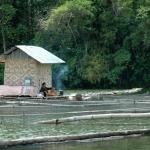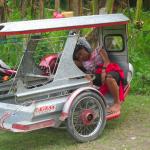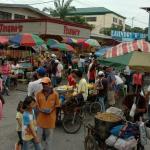Mindanao, seen through the eyes of a Kano.
It's been more than a decade since my first visit to the Philippines, much time has passed by since then and I keep coming back to the wonderful island of Mindanao every year. I hope one day I will call this place my home. Actually I was born in a very small but well developed country named the Netherlands. Being brought up in an open society with all it's social advantages, in the capitol city of Amsterdam, a metropolis with a multiracial, multireligious society and the every day problems that go along with that. But despite all the experiences I encountered in my home country and also during my many travels abroad, this could not even prepare me for the culture shock I had during my first visit to Mindanao back in 1995.
My jaws dropped, it was an awesome experience. It is hard to even begin to describe how I felt, it was so impressive but very exciting. I was stunned by the activities on the streets, the myriad of steetvendors on the road and sidewalks, beggars holding their hands up, grabbing my shirts and hands, asking for money or food. The humid warmth that spreads like a blanket around my body that felt like the temperature in a Turkish bath. All this together with the smell of burning charcoal, barbeque, diesel, firewood and the emission of the many multi-colored vehicles on the road gave me the impression of an organized chaos. Our final destination was Koronadal city in the province of South Cotabato on the island of Mindanao, names and places I never heard of and did not even knew they existed on planet Earth.
My wife was born in Koronadal city in South Cotabato, so, naturally that was the place we visited first, she told me one day she would like to come back to this place and settle down for the rest of our lives. And why not, the town looked like a mix of the ancient Philippines and modern western society. Old wooden structures combined with new concrete buildings.
The town was bustling with activities and people on the streets, dressed in jeans, t-shirts and native clothing, holding cell phones and bolos. It was a small city that felt like a small town. A town filled with contradictions, this was truly a place where East meets the West, or should I say a Westerner meets the East.
I was introduced to many family members and met friends, neighbors and strangers who opened their houses and hearts for me. For some of them it was apparently the first time they met a kano and it seemed they could not help staring at me for a long time. Especially young children could not keep their eyes off me and often wanted to feel my skin and touch my long nose. But I was pleasantly surprised with the attitude of these youngsters, when greeting me they took my right hand and let my knuckle to touch their forehead, this "Mano Po" shows their respect for elderly people. Really something different than the gesture that is more common used in the place where I came from, the raised middle finger from an adolescent stuttering three and four letter words.
During my frequent visits I have learned to be more humble and to show my appreciation and affection for the people that surround me. To be more grateful for the things in daily life that I always consider to be normal and took for granted. They showed me another way of life, taught me another way of thinking and living, this was a real eye-opener.
For me personally, Mindanaoans can be described as some of the warmest, spontaneous, informal and most friendly people in the world, with an unassuming and modest nature they are generally known for their genuine hospitality, immense kindness and spirit of generosity that is extended in whatever way possible.
Hey, Joe, what's your name, give me your money?" , an enthusiastic yell comiong from some children that were roaming the streets of Koronadal city to search for plastic bottles and other materials to sell. Hey, Joe" is the standard Filipino greeting for any foreigner and is derived from the term "GI Joe". I could not take any offense because i knew these playful youngsters meant no harm, so I replied them with "Walang pera" (No money) and a big smile, bearing in mind that i am the stranger, a source of great curiosity fore these kids. My smile was instantly returned, it is true, the Philippines is well known as the land where Asia wears a smile.
Mindanaoans are great on smiles, they smile in almost every situation and for any reason, they will always find a reason to smile, they smile at work, they smile on the streets in traffic jams and they even smile in an argument. Smiles that often can puzzle most westerners like me and there are many things that can be read in their smiles. Even when disaster strikes, when nature show it's nasty side, when grieves is a part of daily life, a Mindanaoan will react with a smile, throw up both hands in the air and say bahala-na; "what will be will be".
I have noticed that Filipinos like to talk a lot (Tsika-Tsika) but their facial expressions is telling a story too. Hands, lips, eyes, eyebrows and smiles are often used to tell a wide range of messages. Being polite in the Netherlands can be different in the Philippines, when talking to another person a fixed eye contact is explained as true interest in that person or his story, it took me some time to find out that this is considered as an aggressive gesture in the Philippines. Being a direct person myself and used to speak my mind when it pleases me, I began to grow a little confused as I realized that I still had a lot to learn in ways of communication and had to make many adjustments in my behavior.
Mingling with my relatives and many others gave me a great feeling of respect for their strength and endurance. During hardship and difficult times they were able to keep up a positive attitude towards life. I always compare the Mindanaoans with bamboo, they will bend, but never break. The devotion to family ties was one of the enduring and praiseworthy values within my newly found family, I could see that the close family ties are a unique nature and it is what holds families together and I decided that not showing up on birthdays and waiting for an invitation was past tense for me.
A Mindanaoan does not show annoyance or anger when things do not go the way they would like it, they do not like to openly disappoint or agree, they rather give you the expected answer, naturally again with a smile. Mindanaoans use a fascinating and nonverbal language, much of it involving facial expressions. Many times i had the idea that people wanted to kiss me when given directions, it was awkward to see that lips are pursed to give me the directions i asked for or pointing out something or somebody. Mindanaons suprised me with more facial expressions, like showing me a direction by shifting their eyes or by pointing with their heads in the direction indicated, or in letting their mouth drop wide open when they could not hear or understand me.
But all the time i am being treated very politely. If there is one thing the Mindanaons have, it is being polite. Younger family members, friends and neighbors call me as "Kuya", a Filipino phrase for "older brother". I appreciated being named Kuya, for me it was a token of respect and it gave me the feeling of being part of the community and being accepted as part of the family. This showes that Mindanaoan express the importance of the group, they like to be with people, a great contradiction of what i was used to in my own country were we value individuality and privacy above anything else.
I was deeply impressed with the attitude of Bayanihan, the helping atittude whenever one is in disastrous need, individuals or a group of people working together for a common good. Never have i seen such close ties between family members and neighbors in our barangay. It was fascinating to see that, despite the spirit of cooperation, camaraderie and communal unity, how everyone differs from each other. Their looks, beliefs and their cultural diversity showed me a rich blend of people, traditions and customs.
Mindanaoans value people more than they value time. I am still measuring time in hours, minutes and seconds. In Mindanao people are less precise and sometimes do not look further than the day of today. Filipino time is considered unlimited and flexible, in fact, almost nothing happens on time and things can unfold at a snail's pace. But I sincerely try to cope with this laid-back attitude of: "what can be done today can always be accomplished tomorrow". That does not mean i don't get a little irritated or stressed now and then, maybe, and i hope, one day i will get rid of this silly Western attitude towards time. Where I live and work llife moves at such a fast pace that it seems to pass by before I could really enjoy it, most of the time I am shut in my home and office, and rarely do I get the chance to go outside. Life moves much slower in Mindanao, here I can find the time to really observe nature, enjoy the serenity of Lake Sebu and the surrounding tropical forest. Here I can take a deep breath of fresh air and experience the impressive scenery around Mt. Matutum, the tranquility and charm of the rice fields in Allah Valley, at least here I can find my own peace of mind.
In Mindanao there is a story or a fantastic impression around every corner, if you know where to look and if you know how to listen you can see things that exists only in the Philippines. Take the story of Christmas for example, people in Mindanao do like to celebrate Christmas for as long as possible! Christmas carols in shops and on the street can already be heard in September. And what about Karaoke or as they call it hereVideoke, Mindanaoans really love to sing and Karaoke is a favorite pastime, people are literally singing their joyous music as loud as their amplifiers will let them. Many karaokebars can be found in every city or village in Mindanao, if there is electricity there will be Karaoke. A real Philippine phenomenon is the Sari-Sari Store, a convenience store. There's one in every streetcorner, offering everything from canned food, sweets, candles, beer to band-aid and cigarettes. The sari-sari store is also a favorite hang out for the local population to meet eachother and gossip, it often is the hub of the neighborhood, a place to get drinks, snacks and to gather.
I will not forget to mention the famous street food, just to name a few like: Kwek-Kwek, Halo-Halo, Barbecue, fishballs, Betamax ( curdled chicken or pork blood, cubed and grilled) lugaw, banana-cue, helmets (chicken heads), IUD (chicken entrails), adidas (chicken feet) and warm taho. This exotic food is distinguished by its local flavor and sold by vendors on the sidewalks and inside the markets. Street foods are tasty and cheap, it will easily remove a hungry feeling and is sold hot or cold, salty, spicy, sour and sweet. It serves enough variety to ensure everyone's tastes are catered for. And I love the food, in Mindanao food is the basis of social life, I could taste tempting food that has a unique mixture of western and eastern cuisine, but in its own way slightly strange, more different, daring and a delicious exception. When it comes to the local cuisine of the Philippines, this exotic Island is better known for its Balut, Durian and Lechon baboy, delicacies for those with an open appetite for the colors and tastes of traditional Philippine food. I always try to keep an open mind about local food and tasted balut, to tell you honestly, it turned out not to be one of my favorite dishes. The Lechon baboy and kinilaw however were really delicious.
Settling down in Koronadal city in the near future is certain, despite being located in a troubled region, this city is undeniably a wonderful and relaxing place to live and it has been this way for many years. It has the best of both worlds, the facilities of a modern city and the strong community ties of a small town with its rich texture of culture, traditions and history, bursting with life and vibrant colors.
I am grateful for the opportunity for my first visit to Mindanao in 1995, grateful for the many visits after that, grateful for the breathtaking panoramas, the natural beauty, exotic attractions and the sights and sounds of it's captivating nature. From its dazzling beaches tropical climate and to its volcanoes and rainforest, Mindanao is a revelation
But most of all the true treasures of Mindanao, the people itself make me feel like coming back home every time I visit. It is this kaleidoscopic array of food, people, treats, traits and traditions that makes Mindanao a cultural tapestry and one of the the most interesting of the Philippine islands. It is a culturally diverse region with a population made up of many local ethnic groups. These living cultures reflects the character of the people, friendly, easy-going and full of passion for life. A passion that is contagious, for it is a passion that burnes inside me. . It is true, home is where my heart is...in Mindanao.
 ThingsAsian
ThingsAsian

















